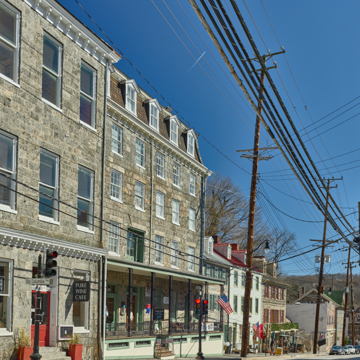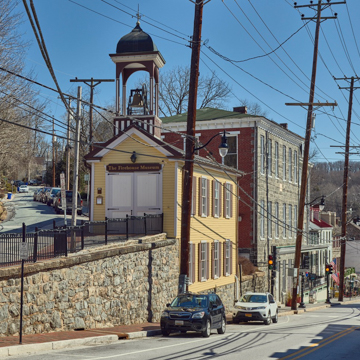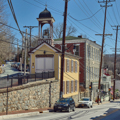The heart of Ellicott City is the Main Street corridor along the old Frederick Turnpike. Most buildings date to the town’s heyday that began in the 1830s, sparked by the arrival of the B&O Railroad and the distribution of the Ellicott brothers’ landholdings. Stone merchant-class single houses appear alongside multi-unit working-class housing, retail shops with residences above, and the former hotels that accommodated travelers along the turnpike and tourists arriving by rail. The city’s prosperity is exhibited by three banks designed by Baltimore architects. An iconic element of the town’s skyline is the cupola of the old Ellicott City Firehouse (1889; 3829 Church Road). As chain department stores emerged, two such local establishments were built: Taylor’s (1924; 8197 Main), and Caplan’s (1926; 8125 Main) both built of buff brick with parapet roof lines, and large display windows. Similarly styled was the Ellicott City Motor service garage and showroom (1921; 8289 Main). The Federal Emergency Administration built the Colonial Revival firehouse (1938–1939, Hubert G. Jory; 8390 Main); and U.S. Post Office (1940–1941; 8267 Main) with murals depicting Ellicott City by Peter DeAnna.
You are here
ELLICOTT CITY COMMERCIAL BUILDINGS
If SAH Archipedia has been useful to you, please consider supporting it.
SAH Archipedia tells the story of the United States through its buildings, landscapes, and cities. This freely available resource empowers the public with authoritative knowledge that deepens their understanding and appreciation of the built environment. But the Society of Architectural Historians, which created SAH Archipedia with University of Virginia Press, needs your support to maintain the high-caliber research, writing, photography, cartography, editing, design, and programming that make SAH Archipedia a trusted online resource available to all who value the history of place, heritage tourism, and learning.





